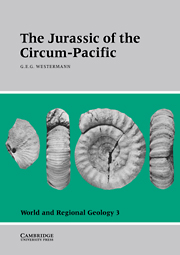Book contents
- Frontmatter
- Contents
- List of contributors
- Preface
- Acknowledgments
- Introduction
- Part I Time scales
- Part II Circum-Pacific base map
- Part III Regional geology and stratigraphy
- Part IV Biochronology
- 12 Ammonite zones of the circum-Pacific region
- 13 Jurassic palynomorphs of the circum-Pacific region
- 14 Radiolarian biozones of North America and Japan
- 15 Ostracods of western Canada
- 16 Bivalve zones and assemblages of the circum-Pacific region
- 17 Belemnites of the southwest Pacific
- Part V Biogeography
- Part VI Climatology and oceanography
- Appendix: Biochronology and atlas with index and guide fossils
- General Index
- Index of Guide- and Indexfossils
16 - Bivalve zones and assemblages of the circum-Pacific region
Published online by Cambridge University Press: 04 August 2010
- Frontmatter
- Contents
- List of contributors
- Preface
- Acknowledgments
- Introduction
- Part I Time scales
- Part II Circum-Pacific base map
- Part III Regional geology and stratigraphy
- Part IV Biochronology
- 12 Ammonite zones of the circum-Pacific region
- 13 Jurassic palynomorphs of the circum-Pacific region
- 14 Radiolarian biozones of North America and Japan
- 15 Ostracods of western Canada
- 16 Bivalve zones and assemblages of the circum-Pacific region
- 17 Belemnites of the southwest Pacific
- Part V Biogeography
- Part VI Climatology and oceanography
- Appendix: Biochronology and atlas with index and guide fossils
- General Index
- Index of Guide- and Indexfossils
Summary
The use of Late Jurassic bivalves (buchiids) in biostratigraphy has been successful in the northern circum-Pacific for a long time. In recent years the increase of detailed studies on other bivalve faunas has extended the potential biostratigraphic usefulness of bivalves to cover also the Early and Middle Jurassic of other circum-Pacific regions. Only some bivalve groups have proved useful, notably monotaceans and pectinaceans for the Lower Jurassic, inoceramids (s.l.) for the Middle Jurassic, and buchiids for the Upper Jurassic. As knowledge of systematics and vertical ranges of bivalve species is still very uneven, many more studies are needed to obtain a comprehensive picture. A correlation chart for several circum-Pacific regions has been compiled showing approximate equivalences (Table 16.1). This chart is mainly intended to stimulate further discussions on this subject.
As seen in Table 16.1, many of the biostratigraphic units recognized thus far are based on and named after local species belonging to mainly circum-Pacific genera, such as Otapiria, Radulonectites, Parainoceramus, Retroceramus (or Mytiloceramus), and Buchia. Although this is only a consequence of the fact that correlation tables are commonly based on offshore species, it makes comparison between circum-Pacific regions easier. This analysis should not overlook the progressive displacement of local vertical ranges of some of these bivalve taxa along their geographic ranges.
- Type
- Chapter
- Information
- The Jurassic of the Circum-Pacific , pp. 300 - 307Publisher: Cambridge University PressPrint publication year: 1993
- 2
- Cited by



